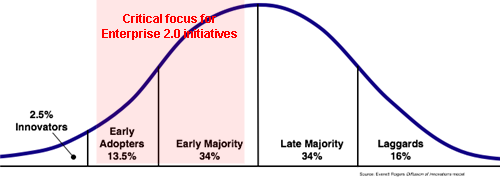Why ‘critical mass’ is intensely relevant to Enterprise 2.0 user adoption
A new perspective on Enterprise 2.0 adoption has just occurred to me, stemming from a conversation with audience members at my KM Forum presentation the other day, and while writing the Implementing Enterprise 2.0 report, which is being created to be out in time for the Enterprise 2.0 Executive Forum.
[UPDATE:] Implementing Enterprise 2.0 is now out with 4 free chapters available for download.
In Diffusion of Innovations, Everett Rogers describes the now well-known curve of user adoption.

Attribution: Creative Commons Attribution 2.5
In the case of Web 2.0 and Enterprise 2.0 technologies, they become more useful the more people use them.
For example, social bookmarking or tagging is of limited value if adopted by just a handful of people, but can be extremely valuable in making information search more effective, if used by the majority of people in an organization.
This changes the shape of the adoption curve. Once there are sufficient users, the value increases, accelerating uptake. This is arguably the case with any system where there are network effects, however the mechanisms of Web 2.0 accelerate this increase in value.
This does not fundamentally transform the nature of user adoption initiatives in organizations, but it does change some of the dynamics and effective strategies.
For Enterprise 2.0 technologies far more than for other technologies, the real focus and the battle needs to be on moving from the early adopter group to the point of ‘critical mass’, where sufficient usage of the technologies is rapidly accelerating their value to users, and uptake is far more rapid.
